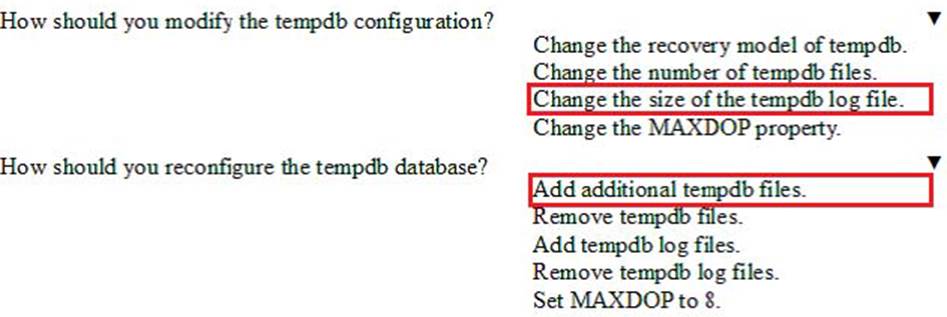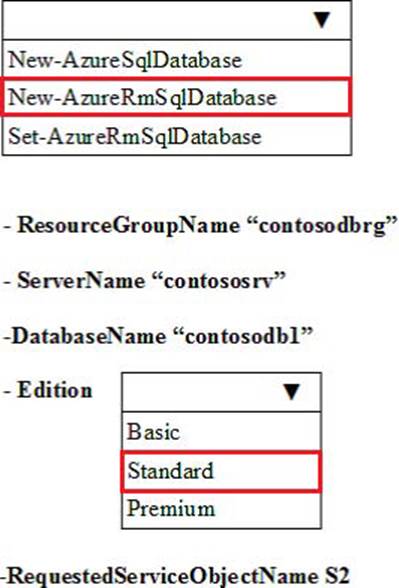Microsoft 70-765 Provisioning SQL Databases Online Training
Microsoft 70-765 Online Training
The questions for 70-765 were last updated at Dec 19,2025.
- Exam Code: 70-765
- Exam Name: Provisioning SQL Databases
- Certification Provider: Microsoft
- Latest update: Dec 19,2025
Topic 4, automobile parts Case Study 1
Background
You manage the Microsoft SQL Server environment for a company that manufactures and sells automobile parts.
The environment includes the following servers: SRV1 and SRV2. SRV1 has 16 logical cores and hosts a SQL Server instance that supports a mission-critical application. The application has approximately 30,000 concurrent users and relies heavily on the use of temporary tables.
The environment also includes the following databases: DB1, DB2, and Reporting. The Reporting database is protected with Transparent Data Encryption (TDE). You plan to migrate this database to a new server. You detach the database and copy it to the new server.
You are performing tuning on a SQL Server database instance. The application which uses the database was written using an object relationship mapping (ORM) tool which maps tables as objects within the application code. There are 30 stored procedures that are regularly used by the application.

HOTSPOT
You need to optimize SRV1.
What configuration changes should you implement? To answer, select the appropriate option from each list in the answer area.

HOTSPOT
You need to resolve the identified issues.
Use the drop-down menus to select the answer choice that answers each question based on the information presented in the graphic.

Topic 5, Contoso, Ltd Case Study 2
Background
You are the database administrator for Contoso, Ltd. The company has 200 offices around the world. The company has corporate executives that are located in offices in London, New York, Toronto, Sydney, and Tokyo.
Contoso, Ltd. has a Microsoft Azure SQL Database environment. You plan to deploy a new Azure SQL Database to support a variety of mobile applications and public websites.
The company is deploying a multi-tenant environment. The environment will host Azure SQL Database instances. The company plans to make the instances available to internal departments and partner companies. Contoso is in the final stages of setting up networking and communications for the environment.
Existing Contoso and Customer instances need to be migrated to Azure virtual machines (VM) according to the following requirements:
The company plans to deploy a new order entry application and a new business intelligence and analysis application. Each application will be supported by a new database. Contoso creates a new Azure SQL database named Reporting. The database will be used to support the company’s financial reporting requirements. You associate the database with the Contoso Azure Active Directory domain.
Each location database for the data entry application may have an unpredictable amount of activity. Data must be replicated to secondary databases in Azure datacenters in different regions.
To support the application, you need to create a database named contosodb1 in the existing environment.
Objects

Database
The contosodb1 database must support the following requirements:
Application
For the business intelligence application, corporate executives must be able to view all data in near real-time with low network latency.
Contoso has the following security, networking, and communications requirements:
HOTSPOT
You need to configure the data entry and business intelligence databases.
In the table below, identify the option that you must use for each database. NOTE: Make only one selection in each column.

HOTSPOT
You need to create the contosodb1 database.
How should you complete the Azure PowerShell command? To answer, select the appropriate Azure PowerShell segments in the answer area.

Topic 6, SQL Server Reporting
Background
You manage a Microsoft SQL Server environment that includes the following databases: DB1, DB2, Reporting.
The environment also includes SQL Reporting Services (SSRS) and SQL Server Analysis Services (SSAS). All SSRS and SSAS servers use named instances. You configure a firewall rule for SSAS.
Databases
Database Name:
DB1
Notes:
This database was migrated from SQL Server 2012 to SQL Server 2016. Thousands of records are inserted into DB1 or updated each second. Inserts are made by many different external applications that your company’s developers do not control. You observe that transaction log write latency is a bottleneck in performance. Because of the transient nature of all the data in this database, the business can tolerate some data loss in the event of a server shutdown.
Database Name:
DB2
Notes:
This database was migrated from SQL Server 2012 to SQL Server 2016. Thousands of records are updated or inserted per second. You observe that the WRITELOG wait type is the highest aggregated wait type. Most writes must have no tolerance for data loss in the event of a server shutdown. The business has identified certain write queries where data loss is tolerable in the event of a server shutdown.
Database Name:
Reporting
Notes:
You create a SQL Server-authenticated login named BIAppUser on the SQL Server instance to support users of the Reporting database. The BIAppUser login is not a member of the sysadmin role.
You plan to configure performance-monitoring alerts for this instance by using SQL Agent Alerts.
DRAG DROP
You create a login named BIAppUser. The login must be able to access the Reporting database.
You need to grant access to the BIAppUser login in the database.
How should you complete the Transact-SQL statements? To answer, drag the appropriate Transact-SQL segments to the correct locations. Each Transact-SQL segment may be used once, more than once, or not at all. You may need to drag the split bar between panes or scroll to view content.

HOTSPOT
You need to open the firewall ports for use with SQL Server environment.
In table below, identify the firewall port that you must use for each service. NOTE: Make only one selection in each column.

HOTSPOT
You need to maximize performance of writes to each database without requiring changes to existing database tables.
In the table below, identify the database setting that you must configure for each database.
NOTE: Make only one selection in each column. Each correct selection is worth one point.

HOTSPOT
You need to set up the service accounts that the database engine and SQL Server Agent services will use.
How should you design the solution? To answer, select the appropriate configuration options in the answer area.

Topic 7, Mix Questions Set
You administer a Microsoft SQL Server 2014 server. One of the databases on the server supports a highly active OLTP application.
Users report abnormally long wait times when they submit data into the application.
You need to identify which queries are taking longer than 1 second to run over an extended period of time.
What should you do?
- A . use SQL Profiler to trace all queries that are processing on the server. Filter queries that have a Duration value of more than 1,000.
- B . Use sp_configure to set a value for blocked process threshold. Create an extended event session.
- C . Use the Job Activity monitor to review all processes that are actively running. Review the Job History to find out the duration of each step.
- D . Run the sp_who command from a query window.
- E . Run the DBCC TRACEON 1222 command from a query window and review the SQL Server event log.
You administer a Microsoft SQL Server 2014 database.
You need to ensure that the size of the transaction log file does not exceed 2 GB.
What should you do?
- A . Execute sp_configure ‘max log size’, 2G.
- B . use the ALTER DATABASE…SET LOGFILE command along with the maxsize parameter.
- C . In SQL Server Management Studio, right-click the instance and select Database Settings. Set the maximum size of the file for the transaction log.
- D . in SQL Server Management Studio, right-click the database, select Properties, and then click Files. Open the Transaction log Autogrowth window and set the maximum size of the file.
Latest 70-765 Dumps Valid Version with 243 Q&As
Latest And Valid Q&A | Instant Download | Once Fail, Full Refund









